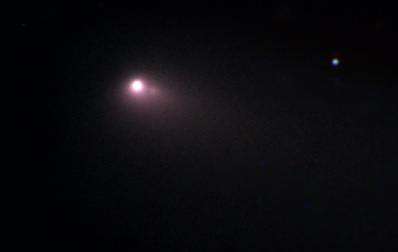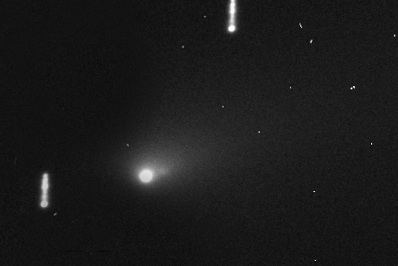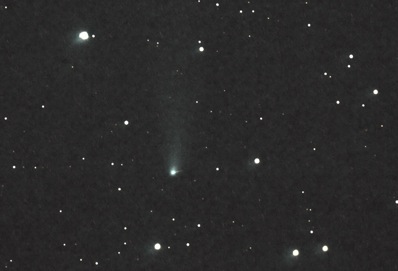


|

|
 |
|
Comet's split caught in the act DR EMILY BALDWIN ASTRONOMY NOW Posted: 19 March On Wednesday Astronomy Now's Nick Howes revealed images that suggest Comet C2007 Q3 Siding Spring is in the process of breaking up. We can now confirm that this is a fragmentation event, and catch up with Nick after his latest stint on the Faulkes Telescope.  Comet C2007 Q3 Siding Spring as imaged by Nick Howes using the Faulkes Telescope North on 17 March at 15:00 UT. Image details: 6 x 60s images in R,G,B filters processed in Maxim DL (DDP). The comet was positioned at RA 15 22.76 and dec +56 12.4. Comet C2007 Q3 Siding Spring as imaged by Nick Howes using the Faulkes Telescope North on 17 March at 15:00 UT. Image details: 6 x 60s images in R,G,B filters processed in Maxim DL (DDP). The comet was positioned at RA 15 22.76 and dec +56 12.4.
“The secondary piece just into the tail in the picture is probably a small fragment or clump of fragments thrown off the main body several days earlier," says top comet scientist Professor Michael Combi from the Department of Atmospheric, Oceanic and Space Sciences at the University of Michgan. "It should continue to drift down the tail and probably fade compared with the main comet itself." Professor Alan Fitzsimmons of Queen's University of Belfast comments that comets splitting apart is not unusual, but are often not bright enough to be seen using amateur telescopes. "Cometary nuclei are extremely fragile and comets frequently split when nowhere near another body, presumably because of thermal stresses on the surface," he says. "It's probable that all splitting events generate multiple fragments but only the brightest are seen in normal images, although subsequent processing may bring out other smaller fragments."  Nick's latest image taken on 19 March confirmed that the secondary condensation is moving with the comet and is not any background stars. The specs in the image are cosmic ray strikes. Nick's latest image taken on 19 March confirmed that the secondary condensation is moving with the comet and is not any background stars. The specs in the image are cosmic ray strikes.
Nick was imaging the comet from his home observatory in Wiltshire as it was passed close to NGC 5907 in the constellation Draco, when he noticed that the comet's tail appeared to change in brightness between 15 and 16 March. Turning to the two metre Faulkes Telescope North, which is based in Hawaii, Nick performed detailed follow-up observations, identifying a detached fragment that did not appear in his earlier images. Having now spent more time on the Faulkes Telescope he confirms that the second cometary fragment is still present. "It's in the raw data clear as anything," he said, just moments after using the Faulkes Telescope this morning to image the magnitude 10 comet. "The angular separation between the primary nucleus and the secondary fragment is between 3 and 5 arcseconds, so it might be possible for amateurs to observe it but it is very faint, and only showed up well in R and G bands." Astronomy Now Online reader John Slinn has also been keeping an eye on the comet. "After reading Nick Howes report of the possibility of Comet Siding Springs breaking up I processed some images I took of the comet last Saturday night (13 March) at the Isle of Wight Star Party," he says. "It appears that the comet has a jet emanating from the nucleus on the right side, and may support Nick's proposal of the comet splitting up afterwards."  John Slinn from the UK sent us this image of Comet Siding, taken on 13 March. Image details: Camera: unmodified Canon 450D; Telescope: Stellavue SV102 ABV mounted at prime focus; Mount: NEQ6 guided with PHD, QHY5 guidecamera on WO66 Zenithstar; Image processing: 8 x 5 minute subs stacked in Deep Sky Stacker. John Slinn from the UK sent us this image of Comet Siding, taken on 13 March. Image details: Camera: unmodified Canon 450D; Telescope: Stellavue SV102 ABV mounted at prime focus; Mount: NEQ6 guided with PHD, QHY5 guidecamera on WO66 Zenithstar; Image processing: 8 x 5 minute subs stacked in Deep Sky Stacker.
Comets are often thought to simply fade away, gradually vaporising as they orbit around the Sun, but with improved observing capabilities it is now known that some comets undergo intense outburst events and fragment into multiple pieces. Comet 17P/Holmes experienced a spectacular outburst event in late 2007, which generated new fragments that appeared as mini-comets in the sky, each with their own coma of dust and ice. Right now Comet C2007 Q3 Siding Spring is heading out of the Solar System, never to return. "Its passage through the inner Solar System has put it on a hyperbolic orbit, which means it will never return but will escape into interstellar space," Fitzsimmons tells Astronomy Now. "If the fragment survives the next few weeks it may also make it out there, in which case it will be just another small inert piece of ice and dust between the stars." Teams of astronomers around the world are now making follow on observations, including a team at Williams University in the USA, before the comet becomes too faint to study.
Related stories: Find out more about the Faulkes Telescope here. |
|
|
|
|